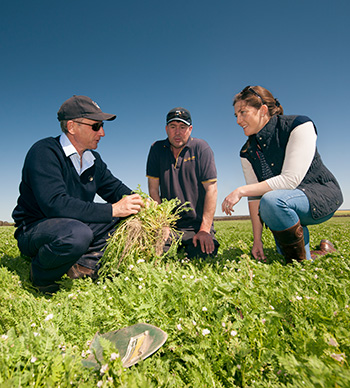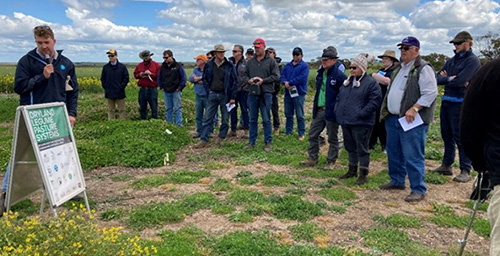Western: Committed growers support hardy pasture legume revolution
Western: Committed growers support hardy pasture legume revolution
Date: 04 Jul 2022

Identification and development of novel hard-seeded pasture legumes teamed with cost-reducing management practices and dedicated extension efforts are heralding a revolutionary change for growers in Western Australia’s low to medium-rainfall regions.
The Dryland Legume Pasture Systems (DLPS) project worked for five years (2017–22) in four states to improve management and better quantify benefits for animal and crop production within mixed-farming systems.
The project had investment from the Grains Research and Development Corporation (GRDC), the Australian Government Department of Agriculture, Water and the Environment (DAWE) as part of its Rural R&D for Profit program, Meat and Livestock Australia (MLA) and Australian Wool Innovation (AWI).
It supported legume pasture research at Murdoch University, the South Australian Research and Development Institute (SARDI), CSIRO, the Western Australian Department of Primary Industries and Regional Development (DPIRD), and New South Wales Department of Primary Industries (DPI).
The DLPS focused on aerial-seeded legume species, which can be harvested on-farm. When combined with twin or summer sowing, a small amount of purchased seed can be established across the farm over 3-4 years at minimal cost. These hard-seeded varieties provide ‘legumes on demand’ that regenerate from the seedbank in the soil after one or more years of cropping.
Lasting benefits of these novel species include increased agility in the choice of crop or pasture production and the production of a highly nutritious forage for livestock, with the potential to reduce methane and greenhouse gas emissions for meat and wool production systems.
These legumes also increase nitrogen fixation in the farming system, reduce the need for fertiliser inputs and boost grain yield and protein contents in following crops.
DPIRD research scientist Dr Angelo Loi said that the DLPS fostered national collaboration which enabled the project team to take the RD&E on these new pasture legume species to the next level for Australian growers.
“Together with colleagues at Murdoch University and CSIRO, we were able to further exploit the unique features of the species under development prior to the DLPS.
“This considered the rotational effects in terms of residual nitrogen, weed and disease levels, and also extending to integrating grazing and testing nutritional benefits for livestock,” Dr Loi said.
The portfolio of species now includes serradella (Ornithopus spp.), biserrula (Biserrula pelecinus), bladder clover (Trifolium spumosum) and gland clover (Trifolium glanduliferum). A release of Trigonella balansae is also expected in coming years, which will complement annual medics on alkaline soils.
Dr Loi estimates that between 20,000 to 40,000 hectares are being sown to the new serradella variety Fran2o across WA’s low to medium-rainfall regions in 2022, plus expansion into NSW.
“Farmers in the dry areas of WA clearly had a diversity problem which added risk to their farming system, and once this was acknowledged, we were able to implement improvements by introducing new pasture species and ramp things up when growers had confidence to really exploit the new system.”
Dr Loi worked closely with a small group of growers who were early adopters of the new species.
“This co-learning approach gave growers the confidence to try a new system that is potentially a game changer for them. This created information to support the benefits of the new species and sowing systems for further extension, and also encouraged growers to champion the changes to other growers.”
Anna-Lisa and Craig Newman at Varley in WA were involved in the DLPS and supported by Dr Loi in a large-scale pasture renovation project.

“We had invested in more land to expand our mixed-farming business to 8300ha, but the poor pastures were in need of renovation. We were given information and confidence by the DLPS to make an ambitious plan to do this,” Anna-Lisa says.
“The scale of what we have achieved, mainly using serradellas and biserrula, is extensive – especially in a low-rainfall region – but for us it coincided with purchasing rundown farms needing a break from cropping, and we were still building sheep numbers so we could push the envelope.
“However, given it’s a low-rainfall zone and 2019 and 2020 were decile-one years, it was quite a test for the novel species and they did exceptionally well.
“We have invested capital upfront to establish the system but are seeing the benefits flow back into the system now. It is still relatively early days but we are hoping to see the trend in our productivity and profitability continue upward as the need for nitrogen fertiliser decreases and soil health improves.”
Grower groups including Mingenew Irwin Group (MIG), Corrigin Farm Improvement Group (CFIG) and ASHEEP Esperance helped direct the research, raised program awareness, established demonstration sites, measured regional pasture benefits and extended the findings within their networks.
DLPS project members also presented throughout the WA wheat/sheep belt and, importantly, organised five pasture tours throughout regions for growers, researchers and advisers.
Nationally, forty-eight demonstration sites were established across the program. While COVID-19 restrictions curtailed the number of field site visits and workshops delivered in some states, more than 9,000 adviser/grower interactions occurred. About 500 growers were estimated to have sown new pasture areas as a result of the work.
Now, early adopters of the legumes in each region have become champions for the new legumes, sharing their experiences and management practices with other growers.
An independent national survey of 400 mixed-farming growers in the low-rainfall zone was commissioned by CSIRO on behalf of the program. Results are still being collated but will quantify current levels of adoption (including DLPS impacts), as well as understand barriers and future drivers of adoption to direct further pasture development.
For more information, read the full article on GRDC’s Groundcover online, or view the Groundcover supplement Dryland pasture legumes, a new era for mixed farms.
Contact Details
Interviews
Stephen Loss, GRDC Senior Regional Manager South
stephen.loss@grdc.com.au
0408 412 453
Contact
Danielle Gault, GRDC Communications Manager
danielle.gault@grdc.com.au
0448 766 881
GRDC Project Code: UMU1805-001RMX,
